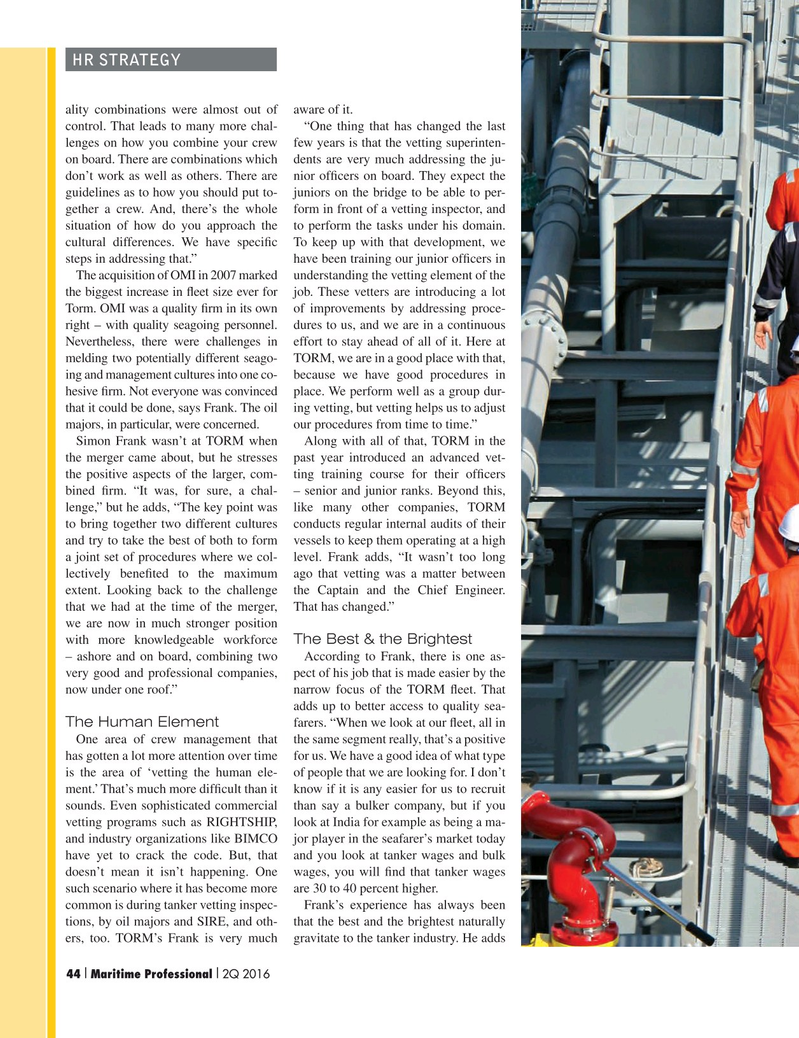
Page 44: of Maritime Logistics Professional Magazine (Q2 2016)
Energy Transport & Support
Read this page in Pdf, Flash or Html5 edition of Q2 2016 Maritime Logistics Professional Magazine
HR STRATEGY ality combinations were almost out of aware of it.
control. That leads to many more chal- “One thing that has changed the last lenges on how you combine your crew few years is that the vetting superinten- on board. There are combinations which dents are very much addressing the ju- don’t work as well as others. There are nior of? cers on board. They expect the guidelines as to how you should put to- juniors on the bridge to be able to per- gether a crew. And, there’s the whole form in front of a vetting inspector, and situation of how do you approach the to perform the tasks under his domain. cultural differences. We have speci? c To keep up with that development, we steps in addressing that.” have been training our junior of? cers in
The acquisition of OMI in 2007 marked understanding the vetting element of the the biggest increase in ? eet size ever for job. These vetters are introducing a lot
Torm. OMI was a quality ? rm in its own of improvements by addressing proce- right – with quality seagoing personnel. dures to us, and we are in a continuous
Nevertheless, there were challenges in effort to stay ahead of all of it. Here at melding two potentially different seago- TORM, we are in a good place with that, ing and management cultures into one co- because we have good procedures in hesive ? rm. Not everyone was convinced place. We perform well as a group dur- that it could be done, says Frank. The oil ing vetting, but vetting helps us to adjust majors, in particular, were concerned. our procedures from time to time.”
Simon Frank wasn’t at TORM when Along with all of that, TORM in the the merger came about, but he stresses past year introduced an advanced vet- the positive aspects of the larger, com- ting training course for their of? cers bined ? rm. “It was, for sure, a chal- – senior and junior ranks. Beyond this, lenge,” but he adds, “The key point was like many other companies, TORM to bring together two different cultures conducts regular internal audits of their and try to take the best of both to form vessels to keep them operating at a high a joint set of procedures where we col- level. Frank adds, “It wasn’t too long lectively bene? ted to the maximum ago that vetting was a matter between extent. Looking back to the challenge the Captain and the Chief Engineer. that we had at the time of the merger, That has changed.” we are now in much stronger position with more knowledgeable workforce The Best & the Brightest – ashore and on board, combining two According to Frank, there is one as- very good and professional companies, pect of his job that is made easier by the now under one roof.” narrow focus of the TORM ? eet. That adds up to better access to quality sea-
The Human Element farers. “When we look at our ? eet, all in
One area of crew management that the same segment really, that’s a positive has gotten a lot more attention over time for us. We have a good idea of what type is the area of ‘vetting the human ele- of people that we are looking for. I don’t ment.’ That’s much more dif? cult than it know if it is any easier for us to recruit sounds. Even sophisticated commercial than say a bulker company, but if you vetting programs such as RIGHTSHIP, look at India for example as being a ma- and industry organizations like BIMCO jor player in the seafarer’s market today have yet to crack the code. But, that and you look at tanker wages and bulk doesn’t mean it isn’t happening. One wages, you will ? nd that tanker wages such scenario where it has become more are 30 to 40 percent higher.
common is during tanker vetting inspec- Frank’s experience has always been tions, by oil majors and SIRE, and oth- that the best and the brightest naturally ers, too. TORM’s Frank is very much gravitate to the tanker industry. He adds
I I 44 Maritime Professional 2Q 2016 34-49 Q2 MP2016.indd 44 5/19/2016 11:38:32 AM

 43
43

 45
45
